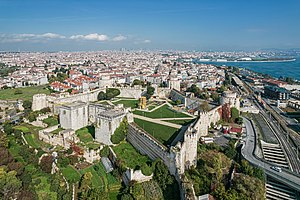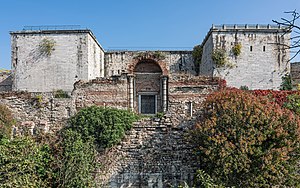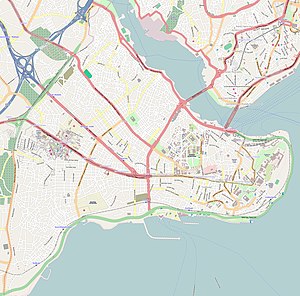Yedikule Fortress
| Yedikule Fortress | |
|---|---|
| Fatih, Istanbul, Turkey | |
 Aerial photograph of Yedikule Fortress | |
| Coordinates | 40°59′36″N 28°55′23″E / 40.9933525°N 28.923093°E |
| Type | Castle |
| Site history | |
| Built | 1458 |
| Built by | Mehmed II |

Yedikule Fortress (Turkish: Yedikule Hisarı or Yedikule Zindanları; meaning "Fortress of the Seven Towers") is a fortified historic structure located in the Yedikule neighbourhood of Fatih, in Istanbul, Turkey.
Built in 1458 on the commission of Ottoman Sultan
The fortress came to be known as the home of a formidable royal dungeon that housed notable figures throughout its history, and the associated intrigue captured the public's imagination over the centuries in various legends, stories, and the arts.
History
After the conquest of Constantinople the Sultan gave priority to official construction projects such as Yedikule and his first seraglio, Saray-i Atik. Yedikule, Fortress of Seven Towers, was erected as the official treasury fort of the Empire around the year 1457 (Özgüven 1996: 95–99).[1] Witnesses described the building as one of the palaces of the Sultan. Each tower of the Yedikule functioned as the storage of precious goods, documents, armoury, coins, and golden and silver ingots. Sultan knew well from his ancestors that protection of the fort was one of the high-priority matters of state (Clavijo 1970: 187–188).[1] That the structure was built as a fortress points out the existence of a military outpost in charge of defending the official treasury against hostile attacks. The treasury was later transferred to the inner section of the Topkapı Palace in the sixteenth century and thereafter Seven Towers became the prison of prestigious captives.
Yedikule was built on the shores of the Marmara Sea, at what was formerly the principal entrance gate to the city. Two towers and two pylons of the former Porta Aurea, the triumphal arch, were inherited from the Byzantine city walls. Three original round towers were added for creating an almost pentagonal plan. When a line is drawn from the midpoint of the former Porta Aurea towards the Ottoman tower in the middle, the axis divides the fortress in two symmetrical parts. A small domed structure, the Conqueror’s Mosque, appears as the focal point of the fortress courtyard, which also marks the midpoint of the axis of symmetry (Gabriel[2]).
Yedikule Fortress was frequently used as a state prison, and ambassadors of states currently at war with the
During the
A
An open-air theater has been built in more recent years, and is used for cultural festivals. Like its namesake in Jerusalem, a Muslim cemetery now lies in front of the Golden Gate.
Notable prisoners
- David of Trebizond, last Emperor of Trebizond (1463)
- Andrea Gritti, Venetian merchant and later Doge of Venice (1499–1502)
- Kartli(1599–1611)
- Future Crimean khans Mehmed III Giray (c. 1610), Selâmet I Giray (c. 1607)
- szlachcic) of the Polish–Lithuanian Commonwealth(1620–1622)
- Sultan of the Ottoman Empire(1622)
- Jakab Harsányi Nagy, Hungarian Turkologist and diplomat (1657–1658)
- Bálint Török, Hungarian aristocrat
- Voivode of Moldavia(1661)
- Pyotr Andreyevich Tolstoy, Russian statesman and diplomat (1710–1714)
- Prince of Wallachia(1714)
- Barthelemy de Lesseps, French diplomat (1798-1801)
- François Pouqueville, French diplomat (1799–1801)
- Albanianpolitician (1904–1908)
See also
References
Sources
- Meyer-Plath, Bruno; Schneider, Alfons Maria (1943), Die Landmauer von Konstantinopel, Teil II (in German), Berlin: W. de Gruyter & Co.
External links
![]() Media related to Yedikule Fortress at Wikimedia Commons
Media related to Yedikule Fortress at Wikimedia Commons

